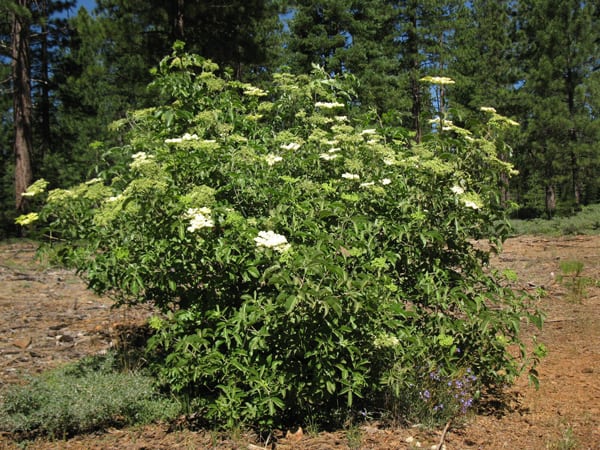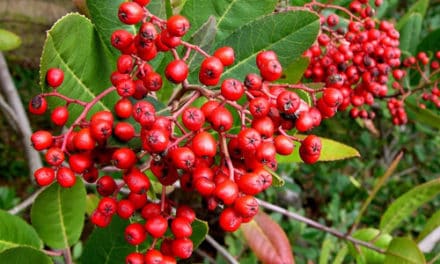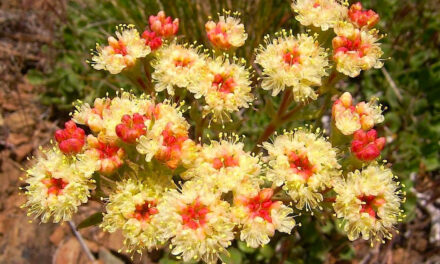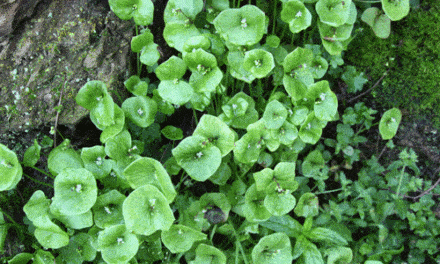By Jim Moore, Entomologist
Long ago in a far away land in Europe there was a mildly sick little boy. While his mother made him some fragrant Elder flower tea, the friendly old man who lived upstairs told the boy the amazing story of the little Elder Tree Mother. When the story was finished the boy could not decide whether the story was real or just a dream.
Here in Northeastern California, in the midst of a clearing in the woods, near where I live , is a little Blue Elderberry shrub. I have not found another anywhere around and about within its’ mountain valley domain. However, it does share something in common with the Elder Tree in the story told to the little boy mentioned above. Both are the same species of elderberry, species Sambucus nigra; with the Blue Elderberry being subspecies Sambucus nigra ssp.caerulea.
Although uncommon up in my area, the native blue elderberry is much more common in other regions in California, especially the coastal ranges, and as far north as British Columbia. Although formerly widespread in California’s Great Central Valley, blue elderberry numbers have been greatly reduced due to extensive loss of riparian habitat. But conservation efforts are underway to restore blue elderberry to some of it’s former range along the Sacramento Valley waterways. This is being done to save the endangered Valley Elderberry Long-horned Beetle whose larva feed within Blue Elderberry branches. Not only will the beetle benefit, but many other wildlife species will also.
Other creatures, especially a great variety of birds, thrive on those fully ripe blue elder ‘berries’ that weigh down the branches so heavily in the summer months. People throughout the world, since the dawn of humanity, have been utilizing the various species of elderberry for food and medicinal purposes. Long ago, the first people to settle within the NorCal mountains and valleys would gather the berry clusters in great quantities, most of which were dried for year round availability. The berries, whether dried or fresh, were cooked in water until a rich and sweet syrup was obtained.

Wild blue elderberries are still harvested by many folks who use them to make jelly, syrup, ice cream, and of course elderberry wine! The fresh flower clusters can be used to make tea, elderflower cordial, and can even be dipped in a batter and deep-fried! Eating fully ripe berries can be done, but it is not recommended, since all parts of the elderberry contain a mild toxin that should be avoided. However, cooking the berries and flower heads destroys the toxin and also improves their flavor.
When harvesting wild blue elderberries in NorCal be aware that there may be several stages on the shrub at the same time: from new flower clusters to fully ripe berries. Only choose the fully ripe berry clusters which will be either black or covered with a protective white waxy film that give the berries their blue appearance. As always, permission should be obtained before harvesting elderberries from the land owners. Better yet, if you have sufficient property of your own, purchase some plants from your local nursery. I have read that blue elderberry is sometimes called “the fastest fruit in the West“ when it comes to producing it’s first bumper crop of berries!
I visit the little lonely blue elderberry bush now and then, but rarely harvest any of its’ abundant berry crop, leaving them instead for the wildlife to enjoy. But this last summer I took some nice photos, and harvested some berries for the purpose of saving the seeds for germination. Perhaps this lonesome elderberry will itself yet become an Elder Tree Mother.
As for the story told to the little boy, long ago, I encourage our readers to go online, and search for the short story called “The Elder-Tree Mother” by Hans Christian Andersen; a clever and delightful story. Hmmm, or is it a Fairy-tale? r











